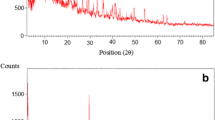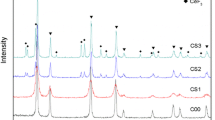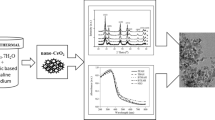Abstract
Stable sols were obtained in the CeO2–Gd2O3 system using the stabilizing additive Hamulsion RUGLAP. The formation of phases in the CeO2–Gd2O3 system with Gd2O3 content of up to 0.07 mol occurs already at the stage of synthesis by the Krekke method. The electrokinetic potential is positive for all samples. A sharp increase in the electrokinetic potential (with Gd2O3 content of over 0.07 mol) is connected with a change in the nature of potential-determining ions of the electrical double layer and the diffusion of excess Gd3+ ions from the solid core of a colloidal particle into its surface. The absorption spectra were analyzed to determine the band gap of colloidal sol particles. With an increase in the cerium oxide content in the sol with the stabilizer (CeO2–Stab), the value of the band gap energy for direct and indirect transitions increases. An additional absorption band appears in the sol spectra based on the CeO2–Gd2O3–Stab system in the 265 ÷ 275 nm wavelength range, the value of the band gap energy for direct transitions 4.46–4.62 eV, presumably, corresponds to solid solutions of Ce1−yGdyO2 type. The suggested stabilizer, which contains silicon oxide, guar gum, and gelatin, is neutral with respect to positively charged sol particles. It is adsorbed on the surface of dispersed particles and isolates them from each other, without causing coagulation of the sol. When gadolinium oxide (0.01 mol) is added to the CeO2 sol, an average particle size decreases to 13 ± 2.8 nm. The nanoparticles are weakly agglomerated, if Gd2O3 content in the sol is up to 0.05 mol; with increasing gadolinium oxide content the size of agglomerates increases. The processes of sol dehydration proceed in the range of 65–90 °C. The activation energy of these processes is in the range of 51–54 kJ/mol. The values of activation energies indicate the presence of moisture in a bound state in the structure of the stabilizing additive Hamulsion RUGLAP.

Highlights
-
Stable sols in the CeО2–Gd2О3 system were obtained by hydrolysis using a stabilizing additive containing proteins and carbohydrates.
-
The electrokinetic potential has a positive value for all sols and decreases with increasing gadolinium oxide content.
-
Compared to a crystalline CeО2 in the CeО2–Gd2О3 system, the band gap, unit cell parameters, and particle size change.
-
Water in sols is held in the structure of the stabilizing additive.






Similar content being viewed by others
References
Ivanov VK, Shcherbakov AB, Baranchikov AE, Kozik VV (2013) Nanocrystalline cerium dioxide: properties, preparation, application. Pub. House Tom. State University, Tomsk, p 284
Barreca D, Gasparotto A, Maccato C, Maragno C, Tondello E, Comini E, Sberveglieri G (2007) Columnar CeO2 nanostructure for sensor application. Nanotechnology 18(12):1–6
Cassee FR, van Balen EC, Singh C, Green D, Muijser H, Weinstein J, Dreher K (2011) Exposure, health and ecological effects review of engineered nanoscale cerium and cerium oxide associated with its use as a fuel additive. Crit Rev Toxicol 41:213–229
Ivanov VK, Shcherbakov AB, Usatenko AV (2009) Structurally sensitive properties and biomedical applications of nano-dispersed cerium dioxide. Uspekhi Khimii 78:855–871
Кarakoti AS, Monteiro-Riviere NA, Aggarwa lR, Davis JP, Narayan RJ, Self WT, McGinnis J, Seal S (2008) Nanoceria as antioxidant: synthesis and biomedical applications. JOM 60(3):33–37
Ivanov VK, Baranchikov AE, Polezhaeva OS, Tret’yakov YuD, Kozik VV (2010) Oxygen nonstoichiometry of nanocrystalline ceria. Russian J Inorganic Chem 55(3):325–327
Gasymova GA, Ivanova OS, Baranchikov AE, Shcherbakov AB, Ivanov VK, Tret’yakov YuD (2011) Synthesis of aqueous solutions of nanocrystalline cerium dioxide doped by gadolinium. Nanosyst: Physics, Chemistry, Mathematics 2(3):113–120
Laberty-Robert C, Long JW, Pettgrew KA, Stroud RM, Rolison DR (2007) Ionic nanowires at 600 °C using nanoarchitecture to optimize electrical transport in nanocrystalline gadolinium doped ceria. Adv Mater 19(13):17–34
Cho M, Sethi R, Narayanan JS, Lee SS, Benoit DN, Taheri N, Decuzzi P, Colvin VL (2014) Gadolinium oxide nanoplates with high longitudinal relaxivity for magnetic resonance imaging. Nanoscale 6(22):13637–13645
Shcherbakov AB, Ivanova OS, Spivak NY, Kozik VV, Ivanov VK (2016) Synthesis and biomedical applications of nano-dispersed cerium dioxide. Pub. House Tom. State University, Tomsk, 476 pp
Dikmen S, Shuk P, Greenblatt M, Gocmez H (2002) Hydrothermal synthesis and properties of Се1−хGdхО2-δ solid solutions. Solid State Sci 4:585–590
Mangalaraja RV, Ananthakumar S, Paulraj M, Uma K, López M, Porro Camurri C, Enrique Avila R (2009) Electrical and thermal properties of 10 mol% Gd3+ doped ceria electrolytes synthesized through citrate combustion technique. Process Appl Ceramics 3(3):137–143
Mahata T, Das G, Mishra RK, Sharma BP (2005) Combustion synthesis of gadolinia doped ceria. J. Alloys Comp 391(1-2):129–135
Deryagin BV, Churaev MV, Muller VM (1985) Surface forces. Nauka, Moscow, p 398
Vallar S, Houivet D, El Fallah J, Kervades D, Haussonne JM (1999) Oxide slurries stability and powers dispersion: optimization with zeta potential and rheological measurements. J Eur Ceram Soc 19:1017–1021
Vincent A, Inerbaev TM, Babu S, Karakoti AS, Self WT, Masunov AE, Seal S (2010) Tuning hydrated nanoceria surfaces: experimental/theoretical investigations of ion exchange and implications in organic and inorganic interactions. Langmuir 26(10):7188–7198
Niftaliev SI, Kuznetsova IV, Saranov IA, Zhundrikova TV, Lygina LV, Tuneekov VY, Chislova IV, Zvereva IA (2019) Synthesis of nanosized gadolinium oxide. Glass Phys Chem 45(3):232–237
Кarakoti AS, Kushibhatla SV, Babu KS, Seal S (2007) Direct synthesis of nanoceria in aqueous polyhydroxyl solutions. J Phys Chem C 111(46):17232–17240
Maensiri S, Masingboon Ch., Laokul P, Jareonboon W, Promarak V, Anderson PL, Seraphin S (2007) Egg white synthesis and photoluminescence of platelike clusters of CeO2 nanoparticles. Cryst Growth Design 7(5):950–955
Truffault L, Magnani M, Hammer P, Santilli CV, Pulcinelli SH (2015) Structural and optical features of ureasiloxane-polyethylene oxide hybrids containing CeO2 nanoparticles. Coll Surf A: Physicochem Eng Aspects 471:73–80
Niftaliyev SI, Kuznetsova IV, Talmi Youssef, Bubnova OG, Chislov MV (2016) Sol-gel synthesis and study of CeO2-Gd2O3 system by thermal analysis method. In Rudskoy AI, Novotortsev VM (eds), Materials of International Conference of Thermal Analysis and Calorimetry in Russia (RTAC-2016). vol 1. SPbPU Publisher, Saint-Petersburg, Russia, pp 274–277
Van Dijken A, Meulenkamp EA, Van Maekelbergh D, Meijerink A (2000) The luminescence of nanocrystalline ZnO particles: the mechanism of the ultraviolet and visible emission. J Luminescence 87–89:454–456
Frolov Yu G (1989) The course of colloid chemistry: surface phenomena and disperse systems. Khimiya, Moscow, p 462
Tasneem M, Siddique F, Farooq AAU (2014) Stabilizers: indispensable substances in dairy products of high rheology. Critical Rev Food Sci Nutr 54(7):869–879
Patsalas P, Logothetidis S, Sygellou L, Kennou S (2003) Structure-dependent electronic properties of nanocrystalline cerium oxide films. Phys Rev B 68(3):1–13
Zhang F, Jin Q, Chan S-W (2004) Ceria nanoparticles: size, size distribution and shape. J Appl Phys 95(8):4319–4326
Pustovarov VA, Trofimova ES, Kuznetsova YuA, Zatsepin AF (2018) Anti-Stox luminescence of Gd2O3 nanocrystals doped with Er3+ and Yb3+ ions. Technical Phys Lett 44(14):42–49
Author information
Authors and Affiliations
Corresponding author
Ethics declarations
Conflict of interest
The authors declare that they have no conflict of interest.
Additional information
Publisher’s note Springer Nature remains neutral with regard to jurisdictional claims in published maps and institutional affiliations.
Rights and permissions
About this article
Cite this article
Niftaliev, S.I., Kuznetsova, I.V., Vlasov, Y.N. et al. Synthesis and morphology of nanodisperse cerium oxide modified by gadolinium oxide. J Sol-Gel Sci Technol 96, 489–497 (2020). https://doi.org/10.1007/s10971-020-05387-9
Received:
Accepted:
Published:
Issue Date:
DOI: https://doi.org/10.1007/s10971-020-05387-9




